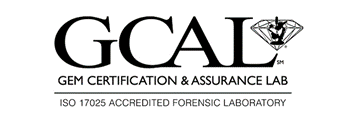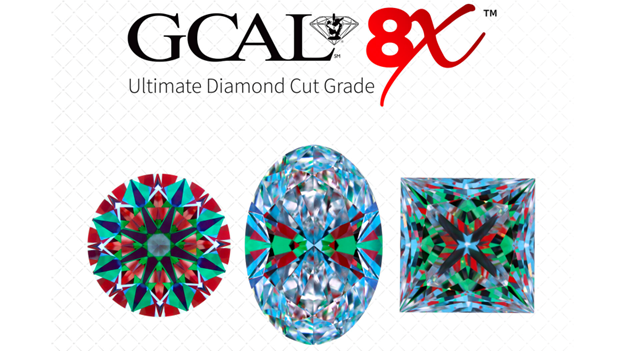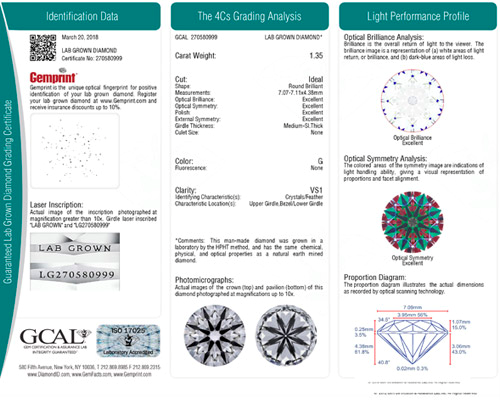This page contains references to diamonds or engagement rings from different companies. Sometimes I do receive a commission when you click on links and buy the products.
GCAL diamond certification is one of the newer certifications on the market today. They don’t share the same prestige you may find from organizations such as the GIA or the AGS (who are actually merging together soon).
Otherwise known as the Gem Certification & Assurance Lab (GCAL), they provide a wide range of certification services, applying to both natural diamonds, synthetic diamonds, and precious metals.
The big question is whether you should buy a diamond that has been certified by the GCAL. Here’s what I think.
- Who Are GCAL?
- The GCAL Approach to Cut Grading
- The GCAL Diamond Certificate of Authenticity
- The GCAL 8X
- GCAL vs IGI
- GCAL vs GIA
- Your Diamond Guru’s Last Say
Who Are GCAL?
GCAL was founded in 2001 by Donald Palmeiri, so they’re not the newest certifiers operating today. However, by certification standards, they’re still quite young. They are headquartered in New York, which is their only location (which can be a benefit).
 One thing that immediately catches my eye about GCAL is that they are certified for ISO 17025, which is a very good certification to get as ISO certification is internationally respected. It tells me that this is a company you can trust.
One thing that immediately catches my eye about GCAL is that they are certified for ISO 17025, which is a very good certification to get as ISO certification is internationally respected. It tells me that this is a company you can trust.
While the GIA grading system has consistently been the benchmark by which other diamond certification organizations set their grading schemes, it seems GCAL is trying to make headway into this arena and really make a name for themselves. They’ve released a grading system known as 8X, which they claim is a grading level so stringent that only the smallest amount of diamond will qualify.
Why a Single Facility?
As I said, GCAL has only one location—a lab in New York. Now, I’m unsure as to the reason behind this and don’t want to speculate, but I can comment on the advantages that comes from this.
First of all, all client concerns can be managed by a single team in-house. This means everyone has insight over each project occurring, and knowledge can easily be shared. Bigger certifiers have been known to have to send information and data hundreds, if not thousands, of miles to their other laboratories. Not only does that invite error, it takes a lot of time.
Secondly, peace of mind is given by the fact diamonds and jewelry are handled in one secure location. There are minimal shipping points which reduce the chance of mistakes or, even worse, lost diamonds. Additionally, one location means it is impossible for them to operate without consistency over branches, which is a problem that plagues larger certifiers.
The GCAL Approach to Cut Grading
GCAL’s approach does seem to be particularly strict. For example, they note that over 50% of GIA diamonds are rated as ‘Excellent Cuts’. However, the testing GCAL has done has revealed that of this percentage, many have rather significant cutting or light performance deficits. If this is to be believed, it potentially shows that the GIA has a more lax approach to their grading, or may miss out a grading technique that GCAL employs.
The GCAL approach encompasses all aspects of assessing diamond cut quality:
- Hearts and arrows;
- Fire;
- Optical brilliance;
- Scintillation;
- Proportions;
- Polish;
- External Symmetry;
- Optical Symmetry.
The entire process includes organic, inorganic, radiochemistry and other grading techniques, all to discover all of a diamond’s little chemical secrets.
Discover More of the Best Diamond Grade Certifications
Evidently, GCAL isn’t the only independent diamond certification organization that grades diamonds today. There are countless others, which does present a problem, especially for the uninitiated diamond buyer.
Which certification is the most trustworthy?
That’s where Your Diamond Guru comes in. I’ve spent years compiling reports, statistics, and eyewitness accounts to determine what certification is worth its salt, and which isn’t worth the paper it’s written on. Head to my certification section to find out more about diamond certification.
The GCAL Diamond Certificate of Authenticity
A GCAL diamond certificate is a document that states that the diamond in question meets the grades given by either the accompanying GIA or AGS grading report. I view its position as acting like multi-factor authentication, where not one, but two distinct levels of reporting are offered as proof of legitimacy. Included in this certificate is:
- An actual size photo;
- A laser inscription photo;
- A proportion diagram;
- An enlarged photomicrograph.
These kinds of in-depth technical reports are actually music to my ears, as it takes a lot of high-quality equipment to produce these things. Laser inscription is a worthwhile inclusion, as it is verifiable proof that the diamond has been graded by GCAL, which is an advantage for customers. This kind of transparency is essentially a ‘trail of breadcrumbs’, where lab reports can be followed back to their origins. It makes GCAL accountable for its diamond grading throughout the lifecycle of the diamond.
Optical Symmetry Analysis
GCAL also includes an optical symmetry analysis in its diamond certification. This type of test analyzes the light that exists a diamond and details the discrepancies in the balance of the diamond. What a diamond wants is symmetry, so this is a pretty useful way of determining the overall quality of the diamond and its light performance.
The GCAL 8X
One thing GCAL claims sets them apart is their 8X cut grade certificate. According to them, less than 1% of all Brilliant Cut diamonds qualify as being 8X. How they can determine this number is curious, and it’s definitely an interesting claim that would take much more work to deem correct.

It’s essentially a way of completely ensuring that diamond buyers can buy without hesitation, knowing full well that what they are buying is of the highest quality.
GCAL vs IGI
When it comes to diamond certification, both GCAL and IGI have carved out their own niches in the industry. The International Gemological Institute (IGI) has long been a trusted name, especially in the realm of lab-grown diamonds. Their extensive experience and consistent grading standards have made them the go-to choice for lab diamonds. This is largely attributed to their early adoption and specialization in this sector, which has given them a competitive edge.
On the other hand, GCAL, or the Gem Certification & Assurance Lab, has been gaining traction for its accuracy, especially when it comes to natural diamonds. Founded in 2001, GCAL may not share the same historical prestige as IGI, but its rigorous grading system, particularly its 8X grading level, has set it apart. Their single facility in New York ensures consistency in grading, reducing the chances of discrepancies that might arise from multiple locations.
In conclusion, while IGI might be the preferred choice for lab-grown diamonds due to their longstanding reputation and expertise, GCAL’s stringent processes make them a reliable choice for natural diamonds.
GCAL vs GIA
The Gemological Institute of America (GIA) is undeniably one of the most renowned and respected names in the diamond certification industry. Their international recognition, coupled with their acquisition of AGSL labs, has solidified their position as a global leader in gemology. As the article mentions, GIA’s grading system has consistently been the benchmark for other diamond certification organizations.
GCAL, while newer in comparison, has been making significant strides in the industry. Their ISO 17025 certification, a testament to their international respect, and their unique grading system, such as the 8X, showcase their commitment to accuracy and innovation. However, it’s essential to note that while GCAL is making a name for itself, GIA’s longstanding reputation and global recognition make it a heavyweight in the industry.
To quote the GIA, “A diamond’s beauty is in its details.” This sentiment is echoed in the meticulous grading processes of both institutions. While GIA remains the more internationally recognized entity, GCAL’s dedication to precision and transparency cannot be overlooked.
Your Diamond Guru’s Last Say
Overall, GCAL certification seems like a fairly trustworthy route for diamonds. Their work seems high-quality, and the fact they only have one location makes diamond grade inflation much less likely to occur. Plus, other reviews seem to have nothing but good things to say about them, with one of them stating GCAL is ‘one of the most reputable third-party diamond grading labs’.
Their services are wide and what is interesting is how many techniques they employ to get to the heart of the matter—an accurate grading. Time will tell if they can fill the void being left by the AGS as it is taken over by the GIA.
That being said, what is evident is that they are utilizing good technology and employing good staff, which for me is a good sign. Plus, if they’re recommended by Blue Nile, I’m more likely to be inclined to trust them.

Richard Jenkins, The Diamond Guru
Get free assistance from the Diamond Guru today. You’ll be glad you did!
- Secure the best quality diamond for your budget.
- Don’t pay over the odds for your diamond ring.
- Have peace of mind that you didn’t get ripped off.
Have a Question? Contact us now…


